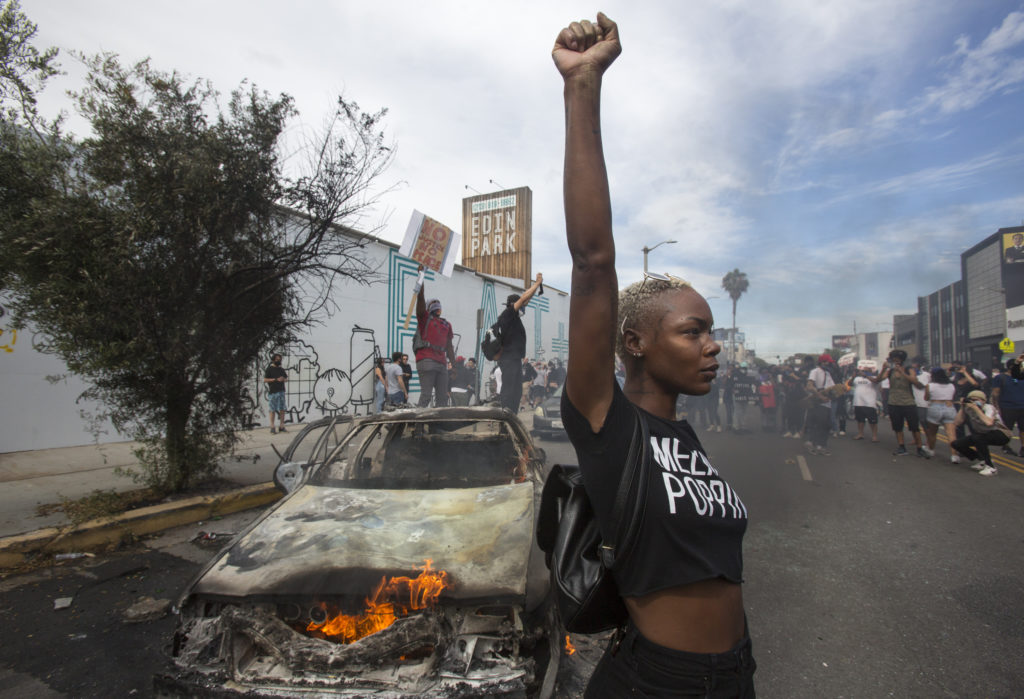For more than a week now, protests have erupted daily across the U.S. in response to the murder of George Floyd by the Minneapolis police. What began in Minneapolis as a small but angry uprising against decades of police violence has now spread to almost every major city in the country, as well as many smaller cities and towns. Chicago, Los Angeles, New York, Oakland, Seattle, Denver, Louisville, Washington D.C., Atlanta, and more than 140 other cities have exploded in anger and unrest. Meanwhile, working people across the world have held solidarity demonstrations and marches in London, Berlin, Auckland, Copenhagen, and Toronto. On Tuesday in Paris, thousands of protesters clashed with police demanding justice for George Floyd and an end to racist policing. Despite the threat of the coronavirus, not to mention police retaliation, hundreds of thousands of people across the world have spontaneously taken to the streets to call for an end to police violence and to directly show their anger for a system that has abandoned them.
Protesters in the U.S. have clashed with police and burned police vehicles, government buildings, and retail stores, and the National Guard has been deployed to several cities and states across the country to quell the unrest. Thousands of protesters have been arrested, hundreds have been injured by “non-lethal” weapons, several have been killed, and at least two reporters have lost eyes after being targeted by police with rubber bullets. Meanwhile, President Trump — no stranger to controversial incitements to violence — has encouraged both the state and armed white vigilantes to attack protesters, and has employed the phrase “when the looting starts, the shooting starts,” demonstrating well where his priorities lie. Since then, there have been at least two instances of white vigilante violence against demonstrators, and on Sunday, a local restaurant owner, David McAtee, was killed by the National Guard in Louisville, Kentucky. His body was left in the street for 12 hours. The next day, on a conference call with U.S. governors, President Trump said their response to the demonstrations had been “weak” and urged them to “dominate” unruly protesters, adding “you have to arrest people, and you have to try people, and they have to go to jail for long periods of time.” These statements came just hours after protesters in Washington D.C. surrounded the White House, lit a guard shack on fire, and clashed with the Secret Service in Lafayette Park while Trump was hidden in the White House bunker.
Despite the President’s rhetoric and the massive disruptions, property damage, and looting, most Americans remain supportive of the protesters and their demands. Social media feeds, including those of several large companies and corporations, are full of messages of solidarity. Meanwhile, a national Reuters poll released on Tuesday showed that 64% of those polled were “sympathetic to people who are out protesting right now” and 47% said they disagreed with the police response so far. Only 27% said they were opposed to the protests. In a Monmouth Poll also released on Tuesday, 78% of respondents said “the anger that led to these protests was justified or fully justified,” and an extraordinary 54% agreed with the same statement even when asked to weigh that support in light of what has transpired during the protests. This suggests that there is, at least for the time being, broad agreement that something needs to be done about the problem of police violence. How far most Americans are willing to go in their support for the protesters remains to be seen, but clearly there are large sectors of the working class ready and willing to stand up for substantive change.
Now is the Time of Monsters
While the events unfolding before us now are very fluid, evolving almost daily, one thing is clear: the nature, range, and volatility of these protests are unlike anything seen in the U.S. for many decades. The immediate equivalent would be the unrest that followed the brutal beating of Rodney King in 1992, which lasted five days and spread from Los Angeles to several cities across the country. But the George Floyd protests have already lasted an entire week, and despite curfews and police repression, they show little immediate sign of slowing down. Furthermore, the social and political context of this week’s uprising is far more dynamic and volatile than in 1992, when U.S. power was at its height. Because of these differences, it’s possible we might see a much longer phase of periodic unrest and revolt not unlike the demonstrations and clashes of the “long hot summer of 1967,” when more than 150 uprisings — mostly in response to police violence — took place across the country over the course of three months. Like the global revolts of the late sixties, of which the long hot summer was but one part, this week’s uprisings are the product of a series of simmering intersecting social, political, and economic crises that have been brought to a boil by the coronavirus pandemic.
But these intersecting crises are themselves part of an even larger and longer ongoing “organic crisis” of capitalism of such proportions and thoroughness that it has called into question the very legitimacy of the entire system. Such situations, as Antonio Gramsci described them, are a kind of interregnum, a period of change in which “the old world is dying, and the new world struggles to be born.” In such a context, we might best understand these protests as perhaps the first of many labor pains we can expect to see over the next several months or years.
However, while these still unresolved crises are hurting working people everywhere, they have, without question, hit Black Americans particularly hard. And as one of the most exploited groups of working people in the United States, it is only natural that they would be the ones at the forefront of these uprisings. The Covid-19 pandemic and the resulting economic crisis, mass unemployment, right wing extremism, and ongoing police violence have devastated Black communities. Black Americans, for instance, are more than three times as likely to die from Covid-19 as white Americans. Since the quarantine, the official unemployment rate for Black Americans has reached 16.7%, two and a half points higher than white unemployment. Meanwhile, Black wealth, which was already devastated by the 2008 economic crisis, is now lower when compared to whites than at any time in the last 40 years. And of course, Black people continue to face oppressive and racist policing and police violence and harassment in their communities. But as the nightly footage of these protests reveals, it is not only Black people who have been rising up.
Black and White Youth at the Proscenium
What we are seeing on the streets now is the expression of widespread anger by a multi-racial vanguard of mostly young people who have been the ones at the forefront of many of these demonstrations and clashes with the police. While police terror and repression are by far the main concerns of the protesters — who have successfully managed already to win the arrest of all four officers involved in Floyd’s murder — it is clear that the outrage goes beyond the police. Police terror, after all, is only the most obvious and blatant example of what are much broader and deeper levels of repression and disenfranchisement. Behind every police killing, there are thousands of young people of color who have been beaten, harassed, and jailed. And behind every police riot, there are millions of working people and people of color facing economic deprivation, illness, domestic violence, unemployment, and food and housing insecurity.
These demonstrations not only reveal the pent up rage of a whole generation of Black and white youth, but also point to a broad and growing distrust of state institutions. The high levels of unemployment that many young people now face, upwards of 30% for those between the ages of 18 and 24, combined with massive debt, falling standards of living, and the ever-present threat of climate change, have left an entire generation with little hope and even less trust in the institutions of business, government, and the police. In a Harvard youth poll conducted on April 23, a full month after the nationwide shutdown, only 8% of Americans between the ages of 18-29 believed the government was working as it should be, while a full 39% believed that institutions needed to be replaced rather than merely reformed. This is a long way from the reformism that just months before had been a regular component of the Left’s support for Democratic Party primary challenger Bernie Sanders.
Just a few months ago, young people were excited about Bernie Sanders’ candidacy. Sanders had captured the aspirations of youth in the United States, and for a brief moment it seemed to many that the Democratic Party might be capable, after all, of being a vehicle for meaningful reforms. However, his campaign was often several steps behind what the mass of his supporters were calling for, and its failure to deliver even a portion of the modest reforms it had promised, not to mention Sanders’s support for the out of touch Joe Biden, left many of his supporters disillusioned and angry. Then came the pandemic, and with it the second massive economic crisis for the millennial generation, which had already come of age in the midst of the 2008 recession. The conditions of the pandemic and the wave of class struggle that have followed have contributed to the radicalization of a whole layer of young and precarious essential and frontline workers. The Black and white youth who march side by side in the street now to the cry of “No Justice, no Peace!” are not making idle threats, and it seems clear that bourgeois peace will not be easy to reestablish.
What Are We Preparing For?
While it is too early to tell whether these protests will continue for weeks or months, or whether clashes between protesters and police will intensify, it is clear that there are millions of young, and even not so young, working people ready to fight. But the movement has many challenges ahead. Sheer spontaneity can wear out and wear down quickly if the movement doesn’t give itself clear goals. Street mobilizations can be powerful, but they are not enough to force the state to end the kinds of racist violence that took the lives of George Floyd, Breonna Taylor, Sean Reed, Ahmed Arbery, and so many others. It remains to be seen whether the movement will become more massive, embrace a clear objective, and begin to organize in more concrete forms of self-organization such as city assemblies capable of acting as ambassadors between the vanguard on the streets and the rest of the working class. Although many unions support the movement and there are many cases of workers’ solidarity throughout the country, this is not enough. The struggles that lie ahead are only going to intensify and therefore it is more vital than ever that the already organized and unorganized sectors of the working class fight together.
The greatest risk hanging over the head of the movement now is that the mobilized vanguard, who have been leading these protests, will be divided from the mass movement. That is certainly the outcome that the Democratic Party would like to see and is already actively pursuing. By distinguishing between good and bad protesters, or between “real activists” and so-called “outside agitators,” the Democratic Party and the Black misleadership class are seeking to split the movement and direct energy back into electoral politics and legislative campaigns. Towards this end, the movement must explicitly reject the politics of the Democratic Party and demand that those politicians responsible for the death of George Floyd and the abuse of protesters, such as Minneapolis Mayor Jacob Frey and Minnesota Governor Tim Walz, resign immediately.
It is important at this time for the movement to continue to denounce and distance itself from the two capitalist parties, in particular the Democratic Party, which claims to represent the Black community, but the Left has to fight as well for the emergence of a new socialist organization in the United States.
It is quite possible that a sector of the vanguard of essential workers and the movement against police brutality will continue to radicalize in search of new political alternatives. That is why socialists, besides being part of the movement and the protests, must also agitate for a definitive break with the Democratic Party and the creation of a socialist party independent of the capitalist parties. Only such an organization can turn this experience of class struggle into a tool for fighting the battles to come. We cannot allow the energy that has been poured into the streets to be diluted by the snake oil of lesser evilism. We need a political organization of our own. The time is now.












